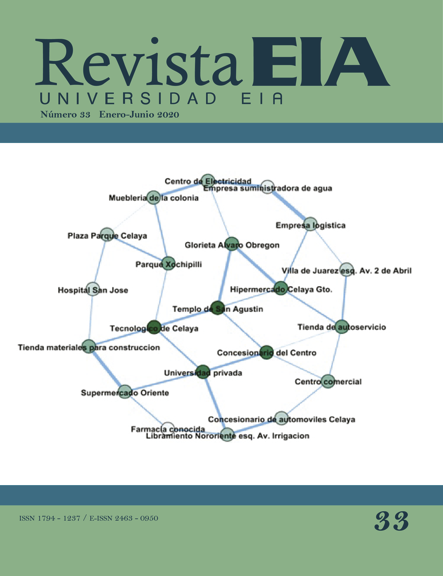Application of complex networks theory for transportation infrastructure analysis: Celaya’s city avenue network
Análisis de la infraestructura de transporte aplicando redes complejas: red de avenidas de la ciudad de Celaya, Guanajuato


This work is licensed under a Creative Commons Attribution-NonCommercial-NoDerivatives 4.0 International License.
Copyright statement
The authors exclusively assign to the Universidad EIA, with the power to assign to third parties, all the exploitation rights that derive from the works that are accepted for publication in the Revista EIA, as well as in any product derived from it and, in in particular, those of reproduction, distribution, public communication (including interactive making available) and transformation (including adaptation, modification and, where appropriate, translation), for all types of exploitation (by way of example and not limitation : in paper, electronic, online, computer or audiovisual format, as well as in any other format, even for promotional or advertising purposes and / or for the production of derivative products), for a worldwide territorial scope and for the entire duration of the rights provided for in the current published text of the Intellectual Property Law. This assignment will be made by the authors without the right to any type of remuneration or compensation.
Consequently, the author may not publish or disseminate the works that are selected for publication in the Revista EIA, neither totally nor partially, nor authorize their publication to third parties, without the prior express authorization, requested and granted in writing, from the Univeridad EIA.
Show authors biography
The streets and avenues networks of a city form the infrastructure of land transport systems. The measures of centrality of complex networks allow to quantify the performance of each intersection of avenues or streets in the network. In this article, Celaya’s city network avenues, was analyzed using the complex networks approach. From betweenness centrality, closeness centrality, diameter and average degree; we identify 5 intersections which play a fundamental role in the city's avenue network as well as its location within the city. The results are of interest for professionals dedicated to the design of logistics systems and transportation.
Article visits 513 | PDF visits 332
Downloads
- Barabási, A. L. (2016). Network Science by Albert-László Barabási. https://doi.org/10.2172/881797
- Boeing, G. (2018). A Multi-Scale Analysis of 27,000 Urban Street Networks: Every US City, Town, Urbanized Area, and Zillow Neighborhood. Environmental and Planning B: Urban Analytics and City Science, 1-18. https://doi.org/10.31235/osf.io/hmhts
- Borgatti, S. P. (2005). Centrality and network flow. Social Networks, 27(1), 55-71. https://doi:10.1016/j.socnet.2004.11.008
- Cardillo, A., Scellato, S., Latora, V., & Porta, S. (2006). Structural Properties of Planar Graphs of Urban Street Patterns. Physical Review E, 73(6), 1-7. https://doi.org/10.1103/physreve.73.066107
- Cats, O. (2017). Topological evolution of a metropolitan rail transport network: The case of Stockholm. Journal of Transport Geography, 62(June), 172-183. https://doi.org/10.1016/j.jtrangeo.2017.06.002
- Cheng, Y.-Y., Roy, L., Lim, E.-p., & Zhu, F. (2015). Measuring centralities for transportation networks beyond structures. In P. Kazienko, & N. Chawla , Applications of Social Mediaand Social Network Analysis (pp. 23-39). New York: Springer. https://doi.org/10.1007/978-3-319-19003-7_2
- Crucitti, P., Latora, V., & Porta, S. (2006). Centrality measures in spatial networks of urban streets. Physical Review E, 73(3), 1-4. doi:10.1103/PhysRevE.73.036125 https://doi.org/10.1103/physreve.73.036125
- de-la-Peña, J. (2012). Sistemas de Transporte en México: un análisis de centralidad en teoría de redes. Revista Internacional de Estadística y Geografía, 3(3), 72-91. https://doi.org/10.5565/rev/redes.438
- Derrible, S. (2012). Network Centrality of Metro Systems. PlosOne, 2012, 1-10. https://doi:10.1371/journal.pone.0040575
- Derrible, S., & Kennedy, C. (2011). Applications of Graph Theory and Network Science to Transit Network Design. Transport Reviews, 31(4), 495-519. https://doi.org/10.1080/01441647.2010.543709
- Freeman, L. C. (1977). A set of measures of centrality based on betweenness. Sociometry, 40(1), 35-41. https://doi.org/10.2307/3033543
- Fruchterman, T., & Reingold, E. (1991). Graph drawing by Force-directed Placement. Software—Practice and Experience, 21(11), 1129-1164. https://doi.org/10.1002/spe.4380211102
- Gephi.org. (2017). Gephi: The Open Graph Viz Platform. From https://gephi.org/
- Huang, L., Zhu, X., Ye, X., Guo, W., & Wang, J. (2015). Characterizing streethierarchies through networkanalysis and large-scale taxitraffic flow: a case studyof Wuhan, China. Environment and Planning B:Planning and Design, 43(2), 276-296. https://doi.org/10.1177/0265813515614456
- Jian, D., Zhao, Y., & Lu, Q.-C. (2015). Vulnerability Analysis of Urban Rail Transit Networks: A Case Study of Shanghai, China. Sustainability, 7(6), 6919-6936. https://doi.org/10.3390/su7066919
- Lotero, R. G. (2014). Vulnerabilidad de redes complejas y aplicaciones al transporte urbano: una revision a la literatura. Revista EIA, 11(21), 67-78. https://doi:10.14508/reia.2014.11.21.67-78
- Newman, M. (2005). A measure of betweenness centrality based on random walks. Social Networks, 27(1), 39-54. https://doi.org/10.1016/j.socnet.2004.11.009
- Newman, M. (2010). Networks: An Introduction. New York, USA: Oxford University Press.
- Rodrigue, J.-P., Slack, B., & Comtois, C. (2017). Green Logistics, in Ann M. Brewer , Kenneth J. Button , David A. Hensher. In Handbook of Logistics and Supply-Chain Management (Vol. 2, pp. 339-350). Handbooks in Transport. https://doi.org/10.1108/9780080435930-021
- Rui, J., Ban, Y., Wang, J., & Haas, J. (2013). Exploring the patterns and evolution of self-organized urban street networks through modeling. The European Physical Journal E, 86(3), 86-74. https://doi.org/10.1140/epjb/e2012-30235-7
- Saberi, M., Mahmassani, H., Brockmann, D., & Hosseini, A. (2016). A complex network perspective for characterizing urbantravel demand patterns: graph theoretical analysisof large-scale origin–destination demand networks. Transportation, 44(6), 1383-1402. https://doi.org/10.1007/s11116-016-9706-6
- Strano, E., Viana, M., da-Fontoura-Costa, L., Cardillo, A., Porta, S., & Latora, V. (2013). Urban street networks, a comparative analysis of ten European cities. Environment and Planning B: Planning and Design, 40, 1071-1086. https://doi.org/10.1068/b38216
- Sun, J., & Tang, J. (2011). A Survey of Models and Algorithms for Social Influence Analysis. In C. Agarwal, Social Network Data Analytics (pp. 177-214). Nueva York: Springer Science. https://doi.org/10.1007/978-1-4419-8462-3_7
- Wang, H., Martin-Hernandez, J., & van Mieghem, P. (2008). Betweenness centrality in a weighted network. Physical Review E, 77, 1-10. https://doi.org/10.1103/physreve.77.046105




